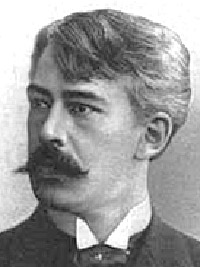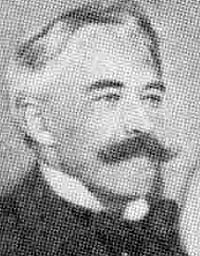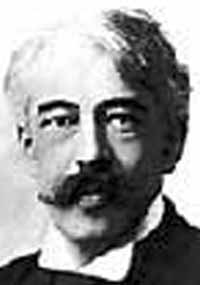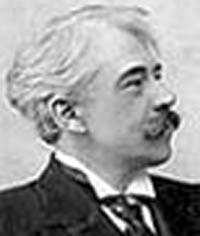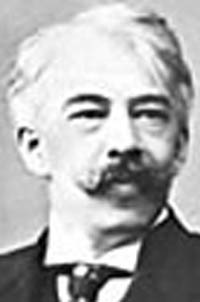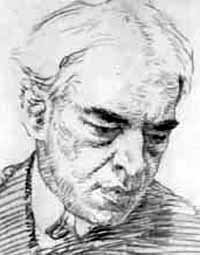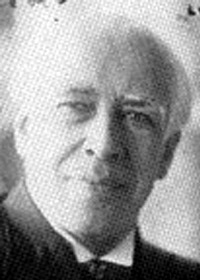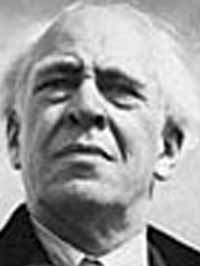Konstantin Stanislavsky
Copyright Michael D. Robbins 2005
Astro-Rayological Interpretation & Charts
Quotes
Biography
Images and Physiognomic Interpretation
Konstantin S. Stanislavsky
January 17, 1863, Moscow, Russia, time not presently available: (Source: 50 Thousand Birthdays) (Ascendant, not calculated though perhaps Virgo might be researched; Sun in Capricorn; Moon either in Sagittarius or Capricorn, if birth was later in the evening; Mercury and Venus widely conjuncted in Aquarius; Mars in Taurus widely conjunct Pluto in Taurus; Jupiter and Saturn in Libra; Uranus in Gemini; Neptune in Aries)

Stanislavsky was the first in a long line of famous Russian teachers of acting. His approach was called the “Method” or “Method Acting”. Actors who study his approach engage themselves in what is called the “Staislavsky Method”. The very fact that it is a method relates it to the seventh ray. Through Capricorn (his Sun sign) the seventh ray expresses most strongly. Clearly, he was working in a fourth ray field, and way no doubt endowed with some of this energy, but his approach was solidly upon the seventh ray.
His purpose was to avoid “mechanical” and artificial acting, and instead to achieve a deep and spontaneous truthfulness. But his method seemed to call for the most meticulous imitation of authentic physical plane behaviors, under the assumption that psychological truth would spontaneously follow the enactment of accurate and truthful physical plane behavior related to that psychological truth. It might be said that Stanislavsky (as many upon the seventh ray) worked “from the outside in”, believing that psychological truth (indispensable to acting) cannot be forced from the psychological level, but can only be evoked from the physical plane. In this respect the Saturn/Venus trine makes sense, as would the Moon in the sign of the Sun—Capricorn.
"Love the art in yourself, not yourself in the art" "The greatest wisdom is to realize one's lack of it" "What is important to me is not the truth outside myself, but the truth within myself." "Do not try to push your way through to the front ranks of your profession; do not run after distinctions and rewards; but do your utmost to find an entry into the world of beauty." "Success is transient, evanescent. The real passion lies in the poignant acquisition of knowledge about all the shading and subtleties of the creative secrets." "In the creative process there is the father, the author of the play; the mother, the actor pregnant with the part; and the child, the role to be born." "At times of great stress it is especially necessary to achieve a complete freeing of the muscles."
Success is transient, evanescent. The real passion lies in the poignant acquisition of knowledge about all the shading and subtleties of the creative secrets
Talent is nothing but a prolonged period of attention and a shortened period of mental assimilation
In the creative process there is the father, the author of the play; the mother, the actor pregnant with the part; and the child, the role to be born."
Remember: there are no small parts, only small actors."
Do not try to push your way through to the front ranks of your profession; do not run after distinctions and rewards; but do your utmost to find an entry into the world of beauty.
Let the wisdom of the old guide the buoyancy and vitality of the youth; let the buoyancy and vitality of the youth sustain the wisdom of the old.
Konstantin (Constantin) Stanislavski
(January 5, 1863–August 7, 1938) was a Russian theatre and acting innovator.Born Constantin Sergeievich Alexeyev in Moscow to a wealthy family, he made his first acting appearance at the age of seven. He took the stage-name Stanislavski early in his career (possibly to preserve the reputation of his family.) In some translations his name is written "Konstantin Stanislavsky".
In 1888, Stanislavski established the Society of Art and Literature at the Maly Theatre, where he gained experience in aesthetics and stagecraft.
In 1898 he co-founded the Moscow Art Theatre (MAT) with Vladimir Nemirovich-Danchenko. The company's first production was Anton Chekhov's The Seagull. It was at MAT that Stanislavski began developing, based on the realist tradition of Aleksandr Pushkin, his famous "System" (often called the "Method", though this is an inaccuracy; method acting was developed from it). "The System" would later be adapted by Lee Strasberg in the United States. Stanislavski's System focused on the development of realistic characters and stage worlds. Actors were instructed to utilise their "emotion memory" in order to naturally portray a character's emotions. In order to do this actors were required to think of a moment in their own lives when they had felt the desired emotion and then replay the emotion in role in order to achieve a more genuine performance.
Stanislavski's System is a complex method for producing realistic characters; most of today's actors, on stage, television, and film, owe much to it. Using "The System", an actor is required to deeply analyse his or her character's motivations. The actor must discover the character's Objective in each scene, and Super Objective for the entire play.
One way of doing this was using Stanislavski's "magic if". Actors were required to ask many questions of their characters and themselves. For example, one of the first questions they had to ask was, "What if I was in the same situation as my character?"
Stanislavski also had an impact on modern opera and boosted the works of writers such as Maxim Gorki and Anton Chekhov.
Stanislavski survived both the Russian Revolution of 1905 and the Russian Revolution of 1917, with Lenin apparently intervening to protect him. In 1918, Stanislavski established the First Studio as a school for young actors and wrote several works: those available in English translation include: An Actor Prepares, Building a Character, Creating a Role, and the biography My Life in Art.born Jan. 5 [Jan. 17, New Style], 1863, Moscow, Russia
died Aug. 7, 1938, Moscow
Stanislavsky also spelled Stanislavski, original name Konstantin Sergeyevich Alekseyev
Russian actor, director, and producer, founder of the Moscow Art Theatre (opened 1898). He is best known for developing the system or theory of acting called the Stanislavsky system, or Stanislavsky method (q.v.).Early influences.
Stanislavsky's father was a manufacturer, and his mother was the daughter of a French actress. Stanislavsky first appeared on his parents' amateur stage at the age of 14 and subsequently joined the dramatic group that was organized by his family and called the Alekseyev Circle. Although initially an awkward performer, Stanislavsky obsessively worked on his shortcomings of voice, diction, and body movement. His thoroughness and his preoccupation with all aspects of a production came to distinguish him from other members of the Alekseyev Circle, and he gradually became its central figure. Stanislavsky also performed in other groups as theatre came to absorb his life. He adopted the pseudonym Stanislavsky in 1885, and in 1888 he married Maria Perevoshchikova, a schoolteacher, who became his devoted disciple and lifelong companion, as well as an outstanding actress under the name Lilina.
Stanislavsky regarded the theatre as an art of social significance. Theatre was a powerful influence on people, he believed, and the actor must serve as the people's educator. Stanislavsky concluded that only a permanent theatrical company could ensure a high level of acting skill. In 1888 he and others established the Society of Art and Literature with a permanent amateur company. Endowed with great talent, musicality, a striking appearance, a vivid imagination, and a subtle intuition, Stanislavsky began to develop the plasticity of his body and a greater range of voice. Praise came from famous foreign actors, and great Russian actresses invited him to perform with them. Thus encouraged, Stanislavsky staged his first independent production, Aleksey K. Tolstoy's The Fruits of Enlightenment, in 1891, a major Moscow theatrical event. Most significantly, it impressed a promising writer and director, Vladimir Nemirovich-Danchenko (1858–1943), whose later association with Stanislavsky was to have a paramount influence on the theatre.
Nemirovich-Danchenko followed Stanislavsky's activities until their historic meeting in 1897, when they outlined a plan for a people's theatre. It was to consist of the most talented amateurs of Stanislavsky's society and of the students of the Philharmonic Music and Drama School, which Nemirovich-Danchenko directed. As the Moscow Art Theatre, it became the arena for Stanislavsky's reforms. Nemirovich-Danchenko undertook responsibility for literary and administrative matters, while Stanislavsky was responsible for staging and production.
The Moscow Art Theatre opened on Oct. 14 (Oct. 26, New Style), 1898, with a performance of Aleksey K. Tolstoy's Tsar Fyodor Ioannovich. But Stanislavsky was disappointed in the acting that night. He found it to be merely imitative of the gestures, intonations, and conceptions of the director. To project important thoughts and to affect the spectators, he reflected, there must be living characters on stage, and the mere external behaviour of the actors is insufficient to create a character's unique inner world. To seek knowledge about human behaviour, Stanislavsky turned to science. He began experimenting in developing the first elements of what became known as the Stanislavsky method. He turned sharply from the purely external approach to the purely psychological. A play was discussed around the table for months. He became strict and uncompromising in educating actors. He insisted on the integrity and authenticity of performance on stage, repeating for hours during rehearsal his dreaded criticism, “I do not believe you.”
Stanislavsky's successful experience with Anton Chekhov's The Seagull confirmed his developing convictions about the theatre. With difficulty Stanislavsky had obtained Chekhov's permission to restage The Seagull after its original production in St. Petersburg in 1896 had been a failure. Directed by Stanislavsky and Nemirovich-Danchenko in 1898, The Seagull became a triumph, heralding the birth of the Moscow Art Theatre as a new force in world theatre. Chekhov, who had resolved never to write another play after his initial failure, was acclaimed a great playwright, and he later wrote The Three Sisters (1901) and The Cherry Orchard (1903) specially for the Moscow Art Theatre.
Staging Chekhov's play, Stanislavsky and Nemirovich-Danchenko discovered a new manner of performing: they emphasized the ensemble and the subordination of each individual actor to the whole, and they subordinated the director's and actors' interpretations to the dramatist's intent. Actors, Stanislavsky felt, had to have a common training and be capable of an intense inner identification with the characters that they played, while still remaining independent of the role in order to subordinate it to the needs of the play as a whole. Fighting against the artificial and highly stylized theatrical conventions of the late 19th century, Stanislavsky sought instead the reproduction of authentic emotions at every performance.
In 1902 Stanislavsky successfully staged both Maksim Gorky's The Petty Bourgeois and The Lower Depths, codirecting the latter with Nemirovich-Danchenko. Among the numerous powerful roles performed by Stanislavsky were Astrov in Uncle Vanya in 1899 and Gayev in The Cherry Orchard in 1904, by Chekhov; Doctor Stockman in Henrik Ibsen's An Enemy of the People in 1900; and Satin in The Lower Depths. Both as an actor and as a director, Stanislavsky demonstrated a remarkable subtlety in rendering psychological patterns and an exceptional talent for satirical characterization. Commanding respect from followers and adversaries alike, he became a dominant influence on the Russian intellectuals of the time. He formed the First Studio in 1912, where his innovations were adopted by many young actors. In 1918 he undertook the guidance of the Bolshoi Opera Studio, which was later named for him. There he staged Peter Ilich Tchaikovsky's Eugene Onegin in 1922, which was acclaimed as a major reform in opera.
In 1922–24 the Moscow Art Theatre toured Europe and the United States with Stanislavsky as its administrator, director, and leading actor. A great interest was stirred in his system. During this period he wrote his autobiography, My Life in Art. Ever preoccupied in it with content and form, Stanislavsky acknowledged that the “theatre of representation,” which he had disparaged, nonetheless produced brilliant actors. Recognizing that theatre was at its best when deep content harmonized with vivid theatrical form, Stanislavsky supervised the First Studio's production of William Shakespeare's Twelfth Night in 1917 and Nikolay Gogol's The Government Inspector in 1921, encouraging the actor Michael Chekhov in a brilliantly grotesque characterization. His staging of Aleksandr Ostrovsky's An Ardent Heart (1926) and of Pierre-Augustin Caron de Beaumarchais's The Marriage of Figaro (1927) demonstrated increasingly bold attempts at theatricality. His monumental Armoured Train 14–69, V.V. Ivanov's play about the Russian Revolution, was a milestone in Soviet theatre in 1927, and his Dead Souls was a brilliant incarnation of Gogol's masterpiece.
While acting in The Three Sisters during the Moscow Art Theatre's 30th anniversary presentation on Oct. 29, 1928, Stanislavsky suffered a heart attack. Abandoning acting, he concentrated for the rest of his life on directing and educating actors and directors.
The Stanislavsky method, or system, developed over 40 long years. He tried various experiments, focusing much of the time on what he considered the most important attribute of an actor's work—bringing an actor's own past emotions into play in a role. But he was frequently disappointed and dissatisfied with the results of his experiments. He continued nonetheless his search for “conscious means to the subconscious”—i.e., the search for the actor's emotions. In 1935 he was taken by the modern scientific conception of the interaction of brain and body and started developing a final technique that he called the “method of physical actions.” It taught emotional creativity; it encouraged actors to feel physically and psychologically the emotions of the characters that they portrayed at any given moment. The method also aimed at influencing the playwright's construction of plays.As founder of the first acting "System", co-founder of the Moscow Art Theatre (1897-), and an eminent practitioner of the naturalist school of thought, Konstantin Stanislavski unequivocally challenged traditional notions of the dramatic process, establishing himself as one of the most pioneering thinkers in modern theatre.
Stanislavski coined phrases such as "stage direction", laid the foundations of modern opera and gave instant renown to the works of such talented writers and playwrights as Maksim Gorki and Anton Chekhov. His process of character development, the "Stanislavski Method", was the catalyst for method acting- arguably the most influential acting system on the modern stage and screen. Such renowned schools of acting and directing as the Group Theatre (1931- 1941) and The Actors Studio (1947-) are a legacy of Stanislavski's pioneering vision.
Like all pioneering thinkers however, Stanislavski stood on the shoulders of giants. Much of the thought and philosophy Stanislavsky applied to the theatre derives from his predecessors. Pushkin, Russia's original literary hero and the father of the native realist tradition, wrote that the goal of the artist is to supply truthful feelings under given circumstances, which Stanislavski adopted as his lifelong artistic motto. - Polyakova, Elena; Stanislavsky
Stanislavsky was born Konstantin Sergeyevich Alexeyev in Moscow on January 5, 1863, amidst the transition from the feudal serfdom of Czarist Russia under the rule of Peter the Great, to the free enterprise of the Industrial Revolution. More than one hundred years prior, Konstantin's ancestor Alexei Petrov had broken the chains of serfdom that bound the family and gained immediate status and wealth as a merchant. By the time Konstantin was born, the Alexeyev business of gold and silver thread production had made the family name well known throughout the world.
Silver and gold were not the only interests of the Alexeyev family. While Konstantin was still very young, the family organized a theatre group called the Alexeyev Circle. Throughout his ascent to a major role on the stage, Konstantin maintained obligations to his family business, organizing shareholder meetings and keeping the accounts in order. However, his preoccupation with all aspects of theatrical production eventually made him a leading member of his family's theatre group.
Reared by a wealthy and generous father, Konstantin was never short of funding in his early stage performances. Ultimately, in order to escape the stereotype of the prodigal son and to be mindful of the reputation of his family, at the age of 25, Konstantin took the stage name Stanislavski. In the same year he established the Society of Art and Literature as an amateaur company at the Maly Theatre, where he gained experience in ethics, aesthetics and stagecraft. As he progressed independently, Stanislavsky began to further challenge the traditional stage approach. In 1898, in cooperation with Vladimir Nemirovich- Danchenko, Stanislavski founded the Moscow Art Theatre, Russia's first ensemble theatre.
"The program for our undertaking was revolutionary. We protested against the old manner of acting and against theatricality, against artificial pathos and declamation, and against affectation on the stage, and inferior conventional productions and decoration, against the star system which had been a bad affect on the cast, against the whole arrangement of plays and against the poor repertoire of the theatres." - Stanislavski
Using the Moscow Art Theatre as his conduit, Stanislavski developed his own unique system of training wherein actors would research the situation created by the script, break down the text according to their character's motivations and recall their own experiences, thereby causing actions and reactions according to these motivations. The actor would ideally make his motivations for acting identical to those of the character in the script. He could then replay these emotions and experiences in the role of the character in order to achieve a more genuine performance. The 17th Century melodrama Tsar Fyodor was the first production in which these techniques were showcased.
"How does an actor act? ... How can the actor learn to inspire himself? What can he do to impel himself toward that necessary yet maddeningly elusive creative mood? These were the simple, awesome riddles Stanislavksi dedicated his life to exploring. Where and how to 'seek those roads into the secret sources of inspiration must serve as the fundamental life problem of every true actor' ... If the ability to receive the creative mood in its full measure is given to the genius by nature", Stanislavski wondered, "then perhaps ordinary people may reach a like state after a great deal of hard work with themselves - not in its full measure, but at least in part." - A Method to Their Madness: The History of the Actors Studio
Using this system, Stanislavski succeeded like no producer or director before him in translating the works of such renowned playwrights as Chekov and Gorki, whose writings were aptly suited to his method. With their social consciousness and emphasis on the importance of imagery and theme rather than plot, they were blank canvasses on which Stanislavski could exercise his artful hand.Stanislavski clearly could not separate the theatre from its social context. He viewed theatre as a medium with great social and educational significance. During the civil unrest leading up to the first Russian revolution in 1905, Stanislavski courageously reflected social issues on the stage. Twelve years later, during the Red October of 1917, Bolshevism had swept through Russia and the Soviet Union was established. In the violence of revolution, Lenin's personal protection saved Stanislavski from being eliminated along with the Czardom. The USSR maintained allegiance to Stanislavski and his socially conscious method of production and his theatre began to produce plays containing Soviet propoganda.
"The revolution thundered in and made its demands on us. There began a period of new explorations, of reappraisal of the old and the search for new ways. At a time when the new for the sake of the new and the negation of everything that had come before held sway in the theatre, we could not reject out of hand all that was fine in the past ... This link with the past and the eagerness to move to an unknown future, the searching quests of the new theatre - all this helped to keep us from succumbing to the dangerous 'charms' of formalism ... We did not succumb; instead we began our quest for new ways, cautiously but doggedly." - Stanislavski
In 1918 Stanislakski established the First Studio as a school for young actors and in his later years wrote two books, My Life in Art and The Actor and His Work. Both have been translated into over 20 languages. Through his earnest professional and educational leadership, Stanislavksi spread his knowledge to numerous understudies, leaving a legacy that cannot be overstated.
"It was with a feeling of deep emotion and joy that we entered Stanislavski's house: a tall old man with snow white hair rose from the arm chair to greet us. It was enough for us to converse with Stanislavski just 5- 10 minutes to come away feeling like a new born person, cleansed of all that might be 'bad' in art." - Khmelyov
In 1938, just before World War II, Stanislavski died holding on to the ideal of a peaceful, socially responsible world. A world completely engulfed in the experiences and interchange of works of art that people of every nation would identify with and cherish.

